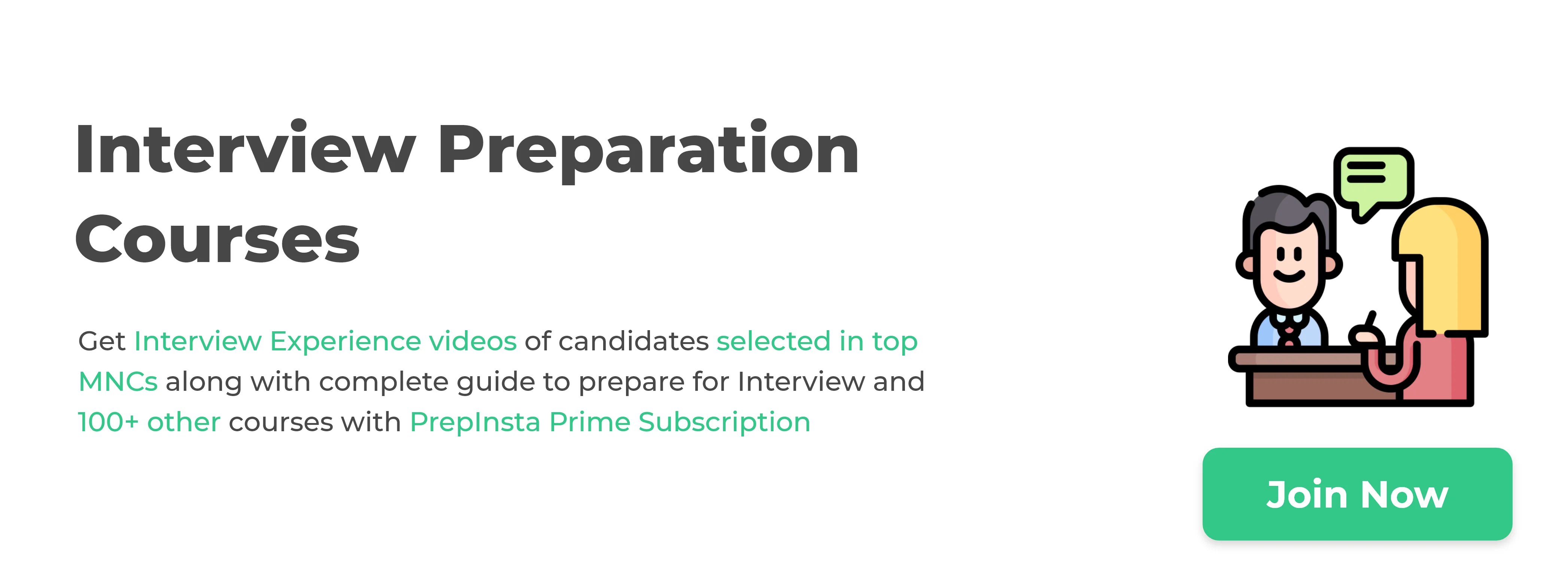Infosys Interview Questions and Answers for Freshers
Infosys Interview Questions and Answers 2023
On this page, you will find actual Infosys interview questions that are shared by the students who gave Infosys interviews in 2023.
Page Highlights:
- Infosys latest Syllabus
- Infosys Technical Questions for CS Candidates
- Infosys HR Questions
- Infosys Technical Questions for Non-CS/ IT candidates

Infosys Latest Syllabus
Infosys has recently modified its exam format. We did a lot of research and came up with the most recent pattern 2023.
| Topic Name | Time | Questions |
|---|---|---|
| Logical | 25 mins | 15 questions |
| Mathematical Ability | 35 mins | 10 Questions |
| Verbal | 20mins | 20 Questions |
| Pseudo Code | 10mins | 5 Questions |
| Puzzle Solving | 10mins | 4 Questions |
| Total | 100mins | 54 Questions |
Infosys Technical Questions for CS Candidates
Question 1: What are DDL and DML commands in SQL?
Answer:
DDL stands for Data Definition Language. DDL commands are used to define database schema, that is, to create and modify the database object structure. CREATE, ALTER, DROP, TRUNCATE, and so on are examples.
DML stands for Data Manipulation Language. DML commands are used to manipulate data in a database. INSERT, UPDATE, and DELETE are a few examples.
Question 2:- What is SDLC?
SDLC is the process by which a software development team designs, builds, maintains, and tests a software product. The software development life cycle is a method of developing a software product in a systematic manner based on the needs of the customer. The life cycle provides various stages for developing a high-quality and efficient software product.
(Use Coupon Code “CT10″ and get 10% off and additional months)
Prime Course Trailer
Related Banners
Get PrepInsta Prime & get Access to all 200+ courses offered by PrepInsta in One Subscription
Question 3: What are the differences between C++ and JAVA?
| C++ | JAVA |
|---|---|
| C++ is a platform independent programming language. | Java is an independent programming language. |
| Used for C++-written system programs such as operating systems. | Used in application programming, such as mobile and web-based apps. |
| Pass by value and pass by reference are both supported. | Only the value can be used to pass variables. |
| Pointers can be explicitly coded for by developers. | Java internally employs pointers. Developers are unable to write programs, implying that pointer support is limited. |
| Allows for operator overloading. | There is no support for operator overloading. |
| Allows for multiple inheritances. | Multiple inheritances are not supported. |
Questions 4: What is the OOPS concept in JAVA? Also, explain them?
Answer:
Data Encapsulation: Data encapsulation is the process of combining data and methods into a single unit known as a class. Data encapsulation aids in the concealment of data from the outside world.
Data Abstraction: Data abstraction refers to the representation of essential features without their background details.
Inheritance: The process of passing existing class properties to a new class is known as inheritance. A subclass is a newly derived class, and a base class is an existing class. Inheritance is beneficial for code reusability.
Polymorphism: The ability of an object to take multiple forms is referred to as polymorphism. Compile-time polymorphism is achieved in Java through method overloading, and run-time polymorphism is achieved through method overriding.
Use Coupon Code “CT10” and get flat 10% OFF on your Prime Subscription :
- 1 month extra subscription on 3 & 6 months plans
- 2 months extra subscription on 12 & 24 months plans
- 3 months extra subscription on 36 & 48 months plan
Question 5: What is the Agile model?
Answer:
The Agile model is a combination of two of iterative and incremental software development. The agile model divides requirements into many parts, known as iterations, and then develops them incrementally. Each iteration in this model is planned, designed, implemented, tested, and deployed to customers for feedback. If any changes are required, they are made during that iteration, and the project is then continued. Any error can be fixed at each iteration, so the presence of errors in the project is not an issue.
Question 6: Write a program to check whether a number is a palindrome or not in C++.
//C++ Program to check whether a number is palindrome or not
#include <iostream>
using namespace std;
//main program
int main ()
{
//variables initialization
int num, reverse = 0, rem, temp;
num = 12321;
cout<<"\nThe number is: "<<num;
temp = num;
//loop to find reverse number
while (temp != 0){
rem = temp % 10;
reverse = reverse * 10 + rem;
temp /= 10;
};
// palindrome if num and reverse are equal
if (num == reverse)
cout <<num<<" is Palindrome";
else
cout <<num <<" is not a Palindrome";
}
// Time Complexity : O(N)
// Space Complexity : O(1)
// where N is the number of digits in num
Question 7: What are the advantages of a waterfall model?
Answer:
Advantages of a waterfall model:
- It is simple to use and comprehend.
- There is no overlap between the phases.
- For small projects, this model is ideal.
- It’s a model with a linear sequence. It operates in a step-by-step manner.
- Because the output of each phase is generated for the next phase, there is a lot of visibility.
- It gives you more options.
- Employees benefit from this model because it provides better documentation.
- The price is low.
- It’s simple to keep up with.
Question 8: What is a View?
Answer:
A view is a virtual table that only contains a subset of a database’s data. Because there are no views, it takes up less storage space. Depending on the connection, data from one or more tables can be combined in a view.
Questions 9: What is the difference between a char and a varchar?
| CHAR | VARCHAR |
|---|---|
| A SQL data type that can be used to store characters. | A SQL data type that allows you to store variable characters. |
| Character is represented by Char. | Varchar represents the character Variable. |
| Values are stored in fixed lengths | Stores values of variable length long with a prefix of 1 or 2 bytes. |
| Static memory allocation is used. | Dynamic memory allocation is used. |
| When the sizes of the column data entries are consistent, the programmer can use char. | When the sizes of the column data entries vary significantly, programmers can use varchar. |
Question 10: List the different types of memory areas allocated by JVM?
Answer
- Class Memory: Saves method data, fields, and method codes, among other things.
- Heap Memory: This type of memory is used to store objects.
- Stack Memory: Memory is allocated to store local variables and the order in which methods are executed in the stack.
- Program Counter: This is a register (PC) that stores the address of the currently executed instruction.
- Native Method Stack: All native methods are stored in the Native Method Stack.
Also Check:-
Infosys HR Questions
Question 1:Tell me about Yourself.
Answer:
Good morning/afternoon Sir/Madam,
I’m ABC, a recent graduate of XYZ College with a B.Tech degree. I’m currently working on a data visualization-based project. I was a member of the Rotaract Club at our college. Throughout my four years at college, I have actively participated in a variety of college events, including our annual college fest and intra-college sports meet, while also honing my skills and completing four projects while maintaining an 8.5 CGPA. I’m interested in this summer internship because I’d like to gain some professional experience and establish a foundation for my future career.
Read more at: Tell me about yourself.
Question 2: What are your hobbies and interests?
Answer:
I was a member of several social clubs, such as Rotaract, and I represented my college at the district level, which allowed me to meet new people and develop skills such as public speaking, leadership, discipline, teamwork, and time management.
Read more at: What are your hobbies and interests?
Question 3: Can you work under pressure?
Answer:
I’m assuming I should because it’s required in my current position.” In my current position as team leader, I am frequently confronted with a variety of difficult situations that require me to work under duress on a regular basis, and I have learned to cope. When I complete a difficult task, I feel as if I’ve gained knowledge that I can apply to my next project.
Read more at: Can you work under pressure?
Question 4: Why do you want to join our company?
Answer:
Sir, I am a fresher. I’m looking for a place where I can give it my all and work hard to get my career off to a good start. It’s a great honour for me to work for such a reputable company as yours, and you’re providing such a fantastic opportunity for freshers like me. I’m a precise person who needs your guidance to improve myself. So that I can give my best in return, with maximum efficiency, increasing your profits while also improving my knowledge.
Read more at: Why do you want to join our company?
Question 5: How quickly do you adapt to new technology?
Answer:
I enjoy learning new things. I am capable of quickly learning new things and then applying what I have learned in a practical manner. In college, I worked on a variety of projects involving technologies that I learned either on my own or through graded programs.
Read more at: How quickly do you adapt to new technology?
Question 6: Who is the current CEO of Infosys?
Answer:
Salil Parekh is the current CEO of Infosys.
Question 7: When was Infosys founded?
Answer:
Infosys was founded on 2nd July 1981 in Pune.
Question 8: What do you know about Infosys?
Answer:
Infosys was a multinational Indian company headquartered in Bangalore that provided consulting, IT, and outsourcing services.
Also Check:-
Infosys Technical Questions for Non-CS/ IT candidates
Question 1: What is RDBMS?
Answer:
A Relational Database Management System (RDBMS) is a collection of programmes that allow a programmer to interact with a database in order to create, update, or delete data. This is accomplished through the use of queries (SQL). Each data element, for example, could be a table row.
Question 2: What is a class?
Answer:
A class is a container for variables of various types and methods that can be combined.
Question 3: Mention the main disadvantages of using C++.
Answer:
Threads aren’t supported by default. If they press you further, you can say that it opposes garbage collection.
Question 4:- What is the fullform of HTML?
Answer:
Hypertext Mark up Language
Question 5:- Mention the 4 basic concepts of OOPS?
Answer:
There are 4 basic concepts of OOPS:
- Encapsulation
- Inheritance
- Abstraction
- Polymorphism
Question 6:- How a local variables is different from a global variable?
Answer:
Local variable: A variable declared within the scope of a function or block is known as a local variable.
Global variable: Global is defined as a variable declared inside or within a function or block.
Question 7:- What are the various types of DMBS?
Answer:
- Relational database management system
- Hierarchical database systems
- Network database systems
- Object-oriented database systems
Question 8:- Define an array.
Answer:
The array is a fundamental data structure that allows you to store multiple items of the same datatype in a reserved and sequential order. Arrays can be divided into three types:
- One dimensional Array
- Two dimensional array
- Multiple dimensional array
Question 9:- What are the various kinds of errors that can occur in C?
Answer:
The two types of C errors are as follows:
- Compile-time errors
- Run-time errors
Question 10:- Mention the different types of arguments?
Answer:
- Call by value
- Call by Reference
Also Check:-
Get over 200+ course One Subscription
Courses like AI/ML, Cloud Computing, Ethical Hacking, C, C++, Java, Python, DSA (All Languages), Competitive Coding (All Languages), TCS, Infosys, Wipro, Amazon, DBMS, SQL and others

 Apply For Jobs
Apply For Jobs Get Hiring Updates
Get Hiring Updates



Hey guys, it would be really helpful if you can provide me Paid Materials for English?????
Hi,
Kindly check it here https://prepinsta.com/infosys/verbal-paid-materials/
For civil engineering students any vacancies
Hi Jeevan,
There are lots of vacancies for civil Engineers as well, it just depends and vary from comnpany to comapany.
And to get more updates regarding Vacancies for do follow us on –
Telegram – http://www.prepinsta.com/telegram
Youtube – https://www.youtube.com/channel/UCVgOWXEyCmRPEVEerK_49Fw
Instagram – https://www.instagram.com/prepinstajobs/?hl=en
This web site is really a walk-through for all of the info you wanted about this and didn’t know who to ask. Glimpse here, and you’ll definitely discover it.